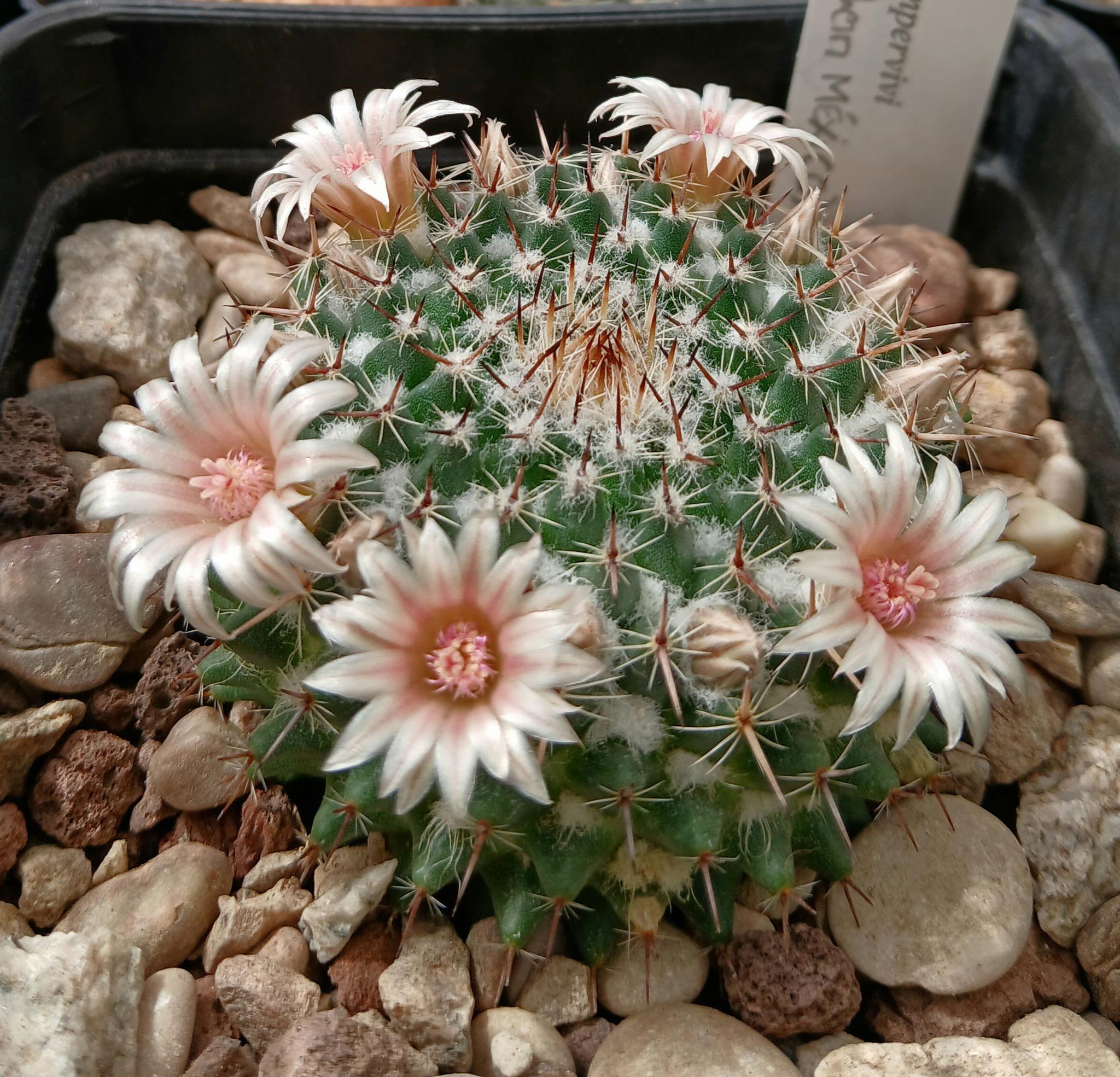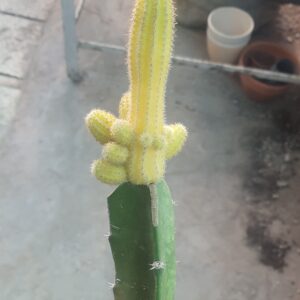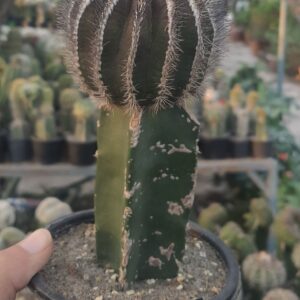Opuntia ‘Snow Fuzzy “The velvety, soft-spined prickly pear is known as Opuntia ‘Snow Fuzzy’.
The prickly pear cactus cultivar known as Opuntia ‘Snow Fuzzy’ is valued for its distinctive soft, thick, white fuzzy spines, which give it a snowy, velvety appearance. This variety, though belonging to the usually prickly Opuntia genus, has glochids (little hair-like spines) that are visually soft but should still be handled with caution since they might still cause skin irritation.
The Snow Fuzzy is a well-liked cactus among collectors and desert gardeners because of its unique texture and manageable size. It is indigenous to the Americas, but it has been selectively cultivated for its decorative attributes. It’s not only beautiful, but it’s also sturdy and simple to care for, making it ideal for both indoor and outdoor use in acceptable climates.
🌿 Botanical Synopsis
Opuntia “”Snow Fuzzy”” is the scientific name.
Common names: White Fuzzy Cactus, Snow Fuzzy Prickly Pear
Cactaceae is the family.
Cultivar originating from species indigenous to North and Central America.
Clumping growth pattern, with flat, rounded pads (cladodes)
Size:
Height: 30 to 90 cm (1 to 3 feet), depending on the circumstances
Width: Extends through pads to create a low, shrub-like mound
USDA Hardiness Zones: 9–11
Flowers and fruits are both available.
The blooming season lasts from late spring to the start of summer.
Flowers:
Golden or brilliant yellow blooms
Usually, they appear from the summits of fully developed pads.
Fruits: Although they can be eaten, they are less common than those of other Opuntia kinds.
Outdoor growth in direct sunshine increases the likelihood of flowering.
Necessities for Light
Sunshine:
Prefers at least six hours of direct sunlight every day and full sun exposure.
Use grow lights indoors, or position them close to a south-facing window.
The white fuzziness is amplified by good sunlight, which also promotes compact growth.
Outside Placement:
Perfect for xeriscaping, desert settings, or rock gardens
Although it can withstand strong sunlight, it thrives in mild exposure to prevent burning.
Humidity and temperature
Temperature:
Between 20 and 35°C (68 and 95°F), it flourishes in warm weather.
When kept dry, may endure brief periods of cold as low as -6°C (20°F).
In colder regions, frost protection is advised.
Humidity:
Like low humidity
Fungal diseases or rot can be caused by high humidity.
In order to avoid moisture buildup, adequate airflow is crucial when growing indoors.
💧 Watering Schedule
The growing season lasts from spring until early fall.
When the ground is very dry, give it plenty of water.
The frequency usually ranges from 10 to 14 days, depending on the climate and the size of the pot.
To avoid fungal spots, don’t splash water on the pads.
Winter Dormancy
Use water sparingly, about once a month.
In the winter, the plant is able to withstand prolonged dry spells.
The main danger is root rot, which is caused by excessive watering.
Requirements for Soil
Kind:
Needs well-draining soil, like:
a mixture of 50% succulents and cacti
25% coarse sand
25% pumice or perlite
pH: Somewhat acidic to neutral (6.0–7.5)
For all Opuntias, it’s essential that the water doesn’t collect around the roots, which is ensured by soil with good drainage.
🌾 Fertilization
During the Growing Season:
Use a balanced cactus fertilizer like 5-10-10 or something similar every month.
To avoid salt accumulation, dilute to half strength.
The Time of Dormancy:
There is no need for fertilization in late fall and winter
✂️ Upkeep and Pruning
Pruning:
Cut off diseased or damaged pads, or prune to maintain the form.
To avoid irritation from glochids, always wear gloves when handling.
Insect Management:
Watch for:
Mealybugs
Insects that scale
Spider mites
For therapy, use insecticidal soap or neem oil.
🌿 Reproduction
By Pads (Cladodes):
With gloves, carefully take off a healthy pad.
Let the cut end heal for five to seven days.
Dry, well-draining soil is ideal for planting.
About a week should pass before the initial watering.
Through Seeds:
Although not as prevalent, it’s conceivable because of the sluggish rate of development.
Patience and warmth are necessary for seed propagation.
Problems That Are Common
Overwatering: Causes pad discoloration and root rot
Sunburn: from being suddenly exposed to strong sunlight, particularly after spending time inside
Mealybugs and mites are pests that may hide among the hairy spines.
To maintain its health, make sure there is a balance of sunlight, dry soil, and adequate ventilation.
🎍 Decorative Uses
Ideal for:
Growing plants in containers
Gardens with rocks and succulents
Indoor exhibits in well-lit rooms
contemporary desert scenery
When planted with succulents with darker or sharp textures, its smooth, snowy texture offers contrast.
✅ Conclusion
The Opuntia Snow Fuzzy is a beautiful, low-maintenance cactus that combines the robustness of prickly pears with a delicate, ornamental twist. With the right care—lots of sunlight, little water, and well-draining soil—this cactus will reward you with consistent growth, distinctive looks, and perhaps even bright yellow flowers.”
Opuntia Snow Fuzzy
Original price was: ₨1,200.00.₨799.00Current price is: ₨799.00.
“The lovely prickly pear cactus variety known as **Opuntia Snow Fuzzy**, also known as the **Snow Fuzzy Cactus**, is notable for its thick layer of soft, white, fuzzy glochids (minute hair-like spines) that give it a velvety, snow-dusted appearance. In contrast to other opuntias with larger spines, this gives it a distinct visual appearance.
It thrives in well-drained, sandy, or rocky soil and full sun exposure, as it is native to dry areas. Water it lightly since it is drought-resistant, and let the soil dry between waterings. It may bloom with yellow or orange blooms during the growing season, which will be followed by edible prickly pear fruits.
Prized for its soft, decorative texture and low maintenance requirements, Opuntia Snow Fuzzy is a well-liked option for succulent collections, rock gardens, and xeriscaping. However, caution should be exercised when handling them because the fluffy glochids can nevertheless cause skin irritation.”





Reviews
There are no reviews yet.